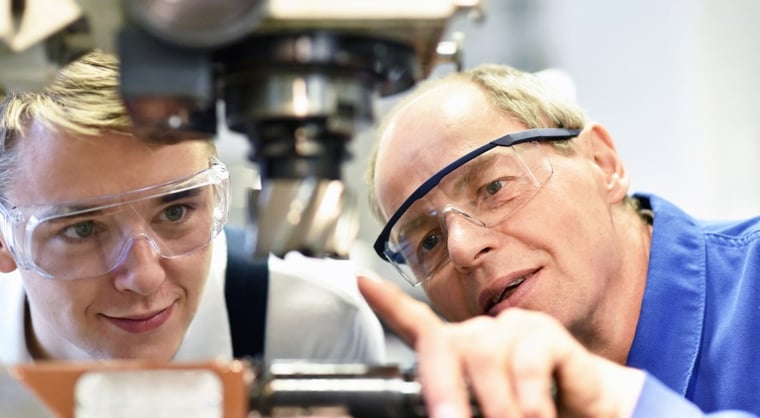Pre-programmed computer software dictates the movements of a milling machine, lathe, robot, or other types of machines. Precision can be incredible — cutting to 0.001” or about 1/4 the width of a human hair — and their repeatability makes CNC machining so efficient.
That complexity may intimidate someone unfamiliar with CNC machine operations, but it shouldn’t. Expert CNC machine training can quickly get a new operator up to speed, producing precise and valuable machined parts and components.
That complexity may intimidate someone unfamiliar with CNC machine operations, but it shouldn’t. Expert CNC machine training can quickly get a new operator up to speed, producing precise and valuable machined parts and components.
We previously explained how people are the most powerful tool in a machine shop, and that remains true for CNC operator training, too. The right attitude, the right trainer, and the right training program can transform a new hire into a powerful, valued team member.
Let’s explore CNC machine training! To be clear, this is Stecker Machine’s approach to CNC machine operator training and may not be followed by every machine shop. In fact, we know some details and steps are covered here that go above and beyond typical training.
Training Basics — Universal values that guide success
Stecker’s decades of experience in not only CNC machining but also operator training provides insights and creates proven processes that inspire employees into rewarding careers.
Before jumping into a daily look at training, let’s cover some basic aspects of CNC machining that are stressed immediately and repeatedly.
- Safety: discussed during the first day of training and every day thereafter
- Quality Management: top priority on quality = machine perfect parts; speed will improve with experience
- Collaboration: teamwork and knowledge-sharing is part of a productive culture
- Asking Questions: this is not encouraged, it’s expected; new hires need to ask questions at every step along the way
Day By Day — A look inside a CNC machine training program
Each day of CNC operator training consists of both classroom learning and machine-side observation and instruction. This balanced approach doesn’t overwhelm a new hire with either technical or real-life information.
- Day 1: Company mission/values/philosophy; overall machine shop safety (equipment, procedures, weather emergencies, etc.); begin specific machine safety operating procedures
- Day 2: Quality management system; common part defects (both raw casting and machined part); how details affect quality
- Day 3: Plex ERP (automated software system) overview and day-to-day usage; gauging tools (measuring different features on different parts)
- Day 4: Tooling (identification, use, capabilities, selection, installation); CNC machining basics (history, techniques, capabilities, code)
This total of 16 hours of classroom CNC training (spread out over two weeks to help absorption) is balanced by machine-side instruction for the remainder of the trainee’s first days.
Helping debur a part (safely remove shards of metal), for instance, allows the trainee to observe the process, become familiar with the part, and understand the steps, all while quality control is emphasized.
Properly loading and unloading parts into a fixture (clamps, alignment, etc.) is key to a well-machine part.
Advanced trainees will also begin auditing parts, measuring all the features that were machined on the part (thread, bore size, machined surface flatness). Depending on how critical a feature is and its tolerance, an audit may be completed every shift, every 2 hours, or even every part.
Finally, an operator can begin actual, live CNC machining. Certain machines are easier to learn than others, many of those being vertical CNC machining centers. Of course, if an employee joins the team with some CNC machining experience, a higher-level machine is appropriate (and training is completed quicker, too).
Goals and Milestones — Reaching levels of achievement
No two trainees are the same, each absorbing training material in different amounts and at different speeds. In high-end CNC machine shops, one-on-one counseling is offered to get struggling students’ confidence levels up.
While written classroom tests can measure book learning, the real value is determined by how an operator performs on a CNC machine. Even after many hours of observing and learning from an experienced operator, a trainee will no doubt make mistakes, which is expected.
It’s when a new operator is consistently making good parts at a high rate that supervisors really start to trust them. Of course, odd and untaught situations will arise for any operator, and that’s when it’s key to ask for help.
In fact, that’s one of the biggest challenges during CNC operator training: when and how often people should ask for help (hint: they should ask far more often than they do!) Perhaps it’s because the machines are so precise and technologically advanced that operators fail to ask for guidance. Yet in the machine shop world, overconfidence can be costly (rework and scrap), so someone who is unsure and asks many questions can end up being more productive.
Culture — The key to an empowered team
Some machine shops are competitive, with operators closely holding operational secrets in an attempt to maintain job security or status. This kind of corporate culture may be the quickest way to crush the spirits of new CNC machine operators and damage the team’s productivity as well as morale.
However, when a company is united toward a common goal of success for the customer, information is shared freely, procedures are universally followed, and questions are expected and welcomed. The more everyone knows, the stronger the team is.
Coworkers are available to assist trainees as they begin to operate CNC machines independently. It helps to have decades of experience nearby to check on parts and progress or lend a hand. Becoming a fully trained operator — comfortable with the Plex ERP system and knowledgeable on quality control — could take two weeks or two months, depending on that trainee’s skills, technical abilities, and overall intuition.
No one can remember everything. So, even in the high-tech world of CNC machining, operators are encouraged to contribute to an ongoing notebook. Notes can be jotted down, so if a situation arises again in the future, a course of action can be determined quickly and confidently.
CNC Operators at Stecker Machine — In-demand skills and endless opportunities
The drive to pursue lifelong learning is a trait many operators have. As long as CNC machines have been around, they are constantly changing, and technology is always evolving. In the machine shop world, there’s always something new to learn.
The opportunity to learn off-site isn’t part of every machine shop’s training regimen. Local educational facilities, technical colleges especially, may offer helpful classes with labs and simulators. For example, a robotics programming class can accelerate learning without taking a robot offline for a day or two in the machine shop, which needs to focus on productivity.
Stecker Machine’s approach to training is to constantly search out new technology, techniques, and knowledge sources while developing improved processes for both new and experienced CNC machine operators. Lastly, having patience can really pay off; a trainee who may initially struggle could be a rockstar with the right guidance.
CNC machining isn’t just a valuable skill, it’s a challenge that can feel complicated and overwhelming at the beginning. Yet, with the right training, some experience, the proper processes — and a collaborative culture — it can be a rewarding career, especially at Stecker.
About 84% of executives agree that there’s a talent shortage in U.S. manufacturing. When you’re ready to learn more about making manufacturing a true career, read our article, 3 Tips to Advance Your Manufacturing Career Path.







